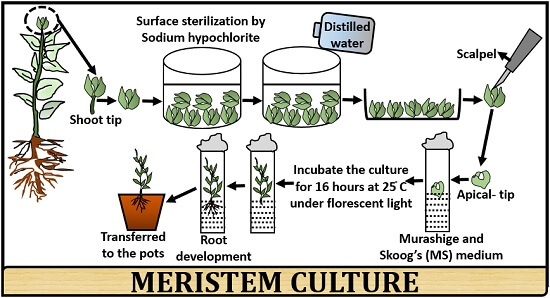Meristem culture particularly involves the cultivation of the shoot apical meristem. This technique is also called a shoot tip or apical meristem culture. It was reported in the year 1952 by the scientist’s named Morel and Martin. Orchid cymbidium was micropropagated using this culture by Morel in 1965.
The meristem culture is very much similar to the technique of micropropagation, which also involves:
- Initiation of culture
- Multiplication of culture
- Rooting of a developed shoot
- Transfer of plantlets to the pots
For the regeneration of plant, Murashige and Skoog’s (MS) medium is prevalently used with low salt concentration for the majority of the species. Fungicides (Bavistin) or antibiotics (chloramphenicol or streptomycin) is also used to remove endophytic contamination. You will get to know the definition, process, uses, advantages, and limitations of the meristem culture method in this context.
Content: Meristem Culture
- Definition of Meristem culture
- What is Meristem?
- Process of Meristem culture
- Applications
- Advantages
- Disadvantages
- Conclusion
Definition of Meristem Culture
Meristem culture is defined as the tissue culture technique, which uses apical meristem with 1-3 leaf primordia to prepare clones of a plant by the vegetative propagation. This technique primarily involves the isolation of meristem by applying a V-Shape cut in the stem. By the culturing of shoot meristem, adventitious roots can be regenerated in this method. The shoot tip’s preferable size is 10 mm for the generation of the virus-free plant, but the shoot tip’s size does not matter in vegetative propagation.
What is Meristem?
Meristem is a part of the plant, which plays a key function to increase the plant length. It possesses meristematic cells that are continuous, oval, polygonal and rectangle in shape. There is no intercellular space between the meristematic cells.

Meristem is the shoot tip, which is found at the shoot apical and root apical region. It is dome-shaped, which is about 0.1 mm wide and 0.25-0.3 mm long. The apical shoot meristem is the portion where a stem elongates and is free of pathogens proved in 1949 before introducing meristem culture.
Limmaset and Cornuet were the two scientists who observed the declined growth of virus towards the apical meristem. Thus, meristem culture is prevalent among other techniques in producing plants free from virus and other related organisms.
Process of Meristem Culture
It involves the following steps:

- Remove the young twigs from the healthy plant.
- Cut the tip portion of the twig that should be of 1 cm.
- Subject the shoot tip to the surface sterilization in the sodium hypochlorite solution for 10 minutes.
- Rinse the explants thoroughly with the distilled water for about 4 times.
- Then, transfer each explant to a sterilized Petri plate.
- Dissect the outer leaves of the shoot tip.
- After the dissection of outer leaves, the apex region will be exposed and separated using a sharp scalpel.
- Transfer the apex or apical meristem to the MS (Murashige and Skoog’s) nutrient medium.
- Incubate the culture under the light at 25 degrees C for 16 hours.
- After the development of a single or multiple shoots, transfer it to the hormone-free medium for the root development.
- Then, transfer the plants to the pots filled compost and keep it under greenhouse condition for hardening.
Applications
- By the Meristem culture, virus-free plants can be produced. The plant meristem that produces heterozygous seeds can be stored in the in-vitro conditions.
- It also helps in the plant breeding technique, in which the hybrid breeds of the plants can be grown. The quarantine authority for the international exchange easily accepts the plants obtained by the meristem culture.
- It is also useful in the micropropagation technique, which involves the vegetative or asexual propagation of the whole plant.
Advantages
- Apical shoot culture also helps in the production of virus-free plants.
- The germplasm or the seeds can be conserved in-vitro or by the cryopreservation method.
- Meristem contains high auxin concentration that promotes plant growth.
Disadvantages
- Isolation of meristem is quite difficult.
- Explants take more regeneration time to grow.
Conclusion
It is a very effective method in agricultural and industrial science, by which clones of a plant can be prepared, and disease-resistant plants can also be developed. For example, the Tobacco Mosaic Virus has been eliminated from the petunia species, and Cauliflower Mosaic Virus has been eliminated from the Brassica oleracea plants.
Thanks, this is a great article.
What is meristem used for?
Meristematic tissues of apical and lateral bud give the basis of cell growth and regeneration in plants, and meristem culture is extensively used in plant virus elimination programs and clonal propagation.
what are the materials required?
To perform meristem culture, we need shoot tip, sodium hypochlorite (NaOCl) solution, distilled water, scalpel, growth medium (Murashige and Skoog’s nutrient medium) and incubator.